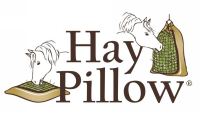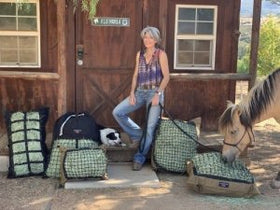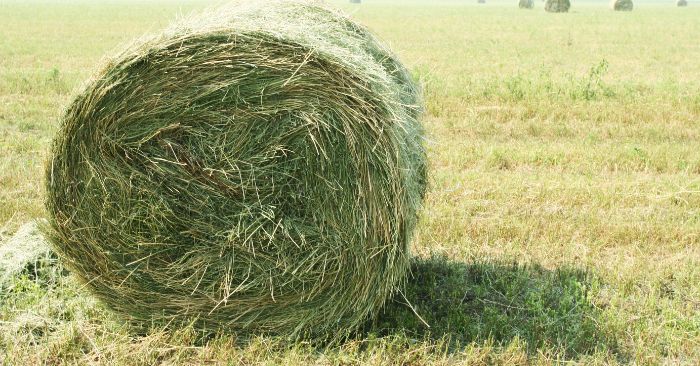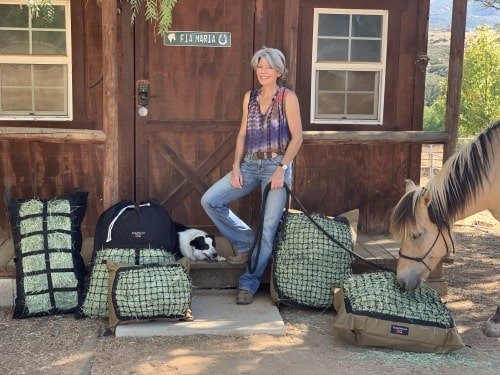Hay Preservatives: 5 Ingredients You Need To Know About
As Featured in Natural Horse Magazine, V 19 Issue 4
The moisture content of hay is monitored prior to baling. With too little moisture, hay becomes brittle, loses nutritional value, and can potentially become unpalatable. Too much moisture can cause hay to mold and experience thermal expansion in storage severe enough to cause combustion creating a severe fire hazard.


5 Common Ingredients Used in Hay Preservatives
1 & 2 - Ammonium Propionate (buffered propionic acid) & Propionic Acid (more corrosive) are organic acids and the most common main ingredients in hay preservatives. Propionic acid was 1st registered as a pesticide in the early 1970’s. In a chronic feeding study using propionic acid, the high dose rats had hyperplasia, ulcers and other effects in the forestomach. Both can cause skin irritation, serious eye irritation and respiratory irritation. Classified by the U. S. Food and Drug Administration as "generally recognized as safe" (GRAS) but is not authorized as a food additive in Europe.
3 - Propylene Glycol is able to lower the freezing point of water and used as aircraft de-icing fluid but is classified by the U. S. Food and Drug Administration as "generally recognized as safe" (GRAS) for use as a direct food additive. It is prohibited for use in food for cats due to links to Heinz body anemia. Possible adverse reactions are: skin and digestive tract irritation, allergic reactions, potentially toxic to the kidneys and liver, neurological symptoms, cardiovascular problems, respiratory issues, potentially bio accumulative.
4 - Ammonium Hydroxide is a colorless liquid chemical solution. It forms when ammonia dissolves in water and is found in many industrial products and cleaners. Some of these are flooring strippers, brick cleaners, and cements. Ammonium hydroxide is poisonous. FDA regulations classify ammonium hydroxide as safe (“generally recognized as safe” or GRAS) at certain levels. Potential adverse reactions are skin irritation, serious eye irritation and respiratory irritation.
5 - Food Dyes: Green No. 3, Yellow No. 5 and Blue No. 1 are commonly added to hay preservatives to present a fresh green appearance and improve marketability. These are carcinogenic.
Some if not all of these may also cause GI tract irritation, being most noticeable to individuals who may have ulcers or a poor gut flora population.
What Hays are More Likely to Contain Preservatives?
Unfortunately hay preservatives are necessary for farmers otherwise too many crops would be destroyed and the price of hay could skyrocket. To be as proactive as possible, ask your grower if they use preservatives. If so, what cuttings/loads/fields received the lowest concentrations and purchase that hay. Inhalation is as much if not more of a health risk as ingestion. Slow feeders may minimize inhalation of acid/chemical dust because they can't bury their nose in the hay. Feeding from ground level allows the nasal passages to drain effectively. If you experience skin or respiratory irritation handling hay, preservatives could be the cause. Whether these additives and preservatives are safe is debatable. If given the choice, I'd rather not handle or feed hay treated with chemicals. Being well informed about the forage you are feeding is prudent and enables you to make educated choices on behalf of your beloved companions. See also: Nitrates in Hay Exposed - What You Need to Know.
More Helpful How-to Slow Feeding Resources
- How to Introduce & Incorporate Free-Choice Forage: A Detailed Action Plan
- Slow Feed Solutions for Any Environment
- A Safer Always Have Hay Source – Mature Grass Hay
- How & Where to Test Your Horse's Hay & Interpret Results
- Sugar Content of Pasture & Hay: Q & A with Katy Watts, Founder of Safergrass.org
- 6 Great Reasons to Feed Your Horse from Ground Level
- 9 Benefits of Slow Feeding Horses
- 7 Slow Feed Dos and Dont's for Horses
- 7 Easy Ways to Help Prevent Colic
- Never Exercise Horses on an Empty Stomach...Ever
- Why Most Horse Prefer to Eat Outside
References:
- Propylene Glycol: The Complicated Additive with Potentially Dangerous Side Effects, retrieved from: https://draxe.com/nutrition/propylene-glycol/
- What’s the Right Moisture Content for Your Hay Bales? retrieved from: https://www.delmhorst.com/blog/moisture-content-in-hay-bales
- Food Dyes Linked to Cancer, retrieved from: https://draxe.com/food-dyes-linked-to-cancer/
- Ammonium hydroxide poisoning, retrieved from: https://medlineplus.gov/ency/article/002491.htm
- Scientific Opinion on the safety and efficacy of propionic acid, sodium propionate, calcium propionate and ammonium propionate for all animal species, retrieved from: https://www.efsa.europa.eu/en/efsajournal/pub/2446
- US EPA Archive Document Propionic Acid, retrieved from: https://archive.epa.gov/pesticides/reregistration/web/pdf/4078fact.pdf





2 Comments -
Hay Pillow Inc • -
Renae •
Hi Renae, It could be you are allergic to the rabbits, hay preservatives or something else in the hay like mold or dust.
Hello I just read your article on hay Preservatives. Im wondering if you have any suggestions or opinions on my situation. My husband brought home 3 bunnies for pets which at first i was fine with, thinking they would be keep outside for the most part. He had them in dog kennels in our house for a few weeks and would let them run around the house and kept saying he was gonna to buy them outdoor shelters which I finally had went out and bought two. He has been stubborn insisting they stay as indoor pets and free roam. This has been going on for sometime now and off and on I have issues with my nose draining and constantly having to blow or lungs. He buys cheap bundles of hay from the local co-op and has three boxes in the house that he constantly puts hay in daily. Do you think this exposure to these hays can be unhealthy to me and my grandchildren?